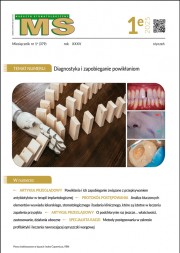Dostęp do tego artykułu jest płatny.
Zapraszamy do zakupu!
Po dokonaniu zakupu artykuł w postaci pliku PDF prześlemy bezpośrednio pod twój adres e-mail.
Helena Martynowicz, Paweł Dymczyk, Dariusz Paliga, Renata Paliga, Rafał Poręba, Paweł Gać, Anna Wojakowska, Grzegorz Mazur, Mieszko Więckiewicz
Streszczenie
Bruksizm i bezdech senny należą do najczęściej rozpoznawanych zaburzeń snu. Celem pracy była ocena częstości występowania bruksizmu w czasie snu oraz bezdechu sennego wśród 63 pacjentów gabinetu stomatologicznego za pomocą nowej metody – poligrafii oddechowej z opcją oceny bruksizmu. Bruksizm oceniano na podstawie zapisu elektromiograficznego z mięśni żwaczy wraz z oceną dźwięku zgrzytania. Stwierdzono wysoką częstość bruksizmu (65%) oraz bezdechu sennego (58%). Ze względu na dobrą charakterystykę, potencjalną dostępność i stosunkowo niski koszt w porównaniu ze złotym standardem, czyli polisomnografią, metoda ta powinna być rozważana jako postępowanie z wyboru w diagnostyce zaburzeń snu w praktykach stomatologicznych.
Abstract
Bruxism and sleep apnea are among the most commonly diagnosed sleep disorders. The aim of the study was to assess the incidence of sleep bruxism and sleep apnea among 63 patients in the dental office using a new method – respiratory poligraphy with the option of bruxism evaluation. Bruxism was assessed based on the electromyographic record of the masseter muscles along with the assessment of the grinding sound. There was a high frequency of bruxism (65%) and sleep apnea (58%). Due to the good characterization, potential availability and relatively low cost compared to the gold standard examination i.e. polysomnography, this method should be considered as a method of choice in the diagnosis of sleep disorders in dental practices.
Hasła indeksowe: bruksizm w czasie snu, bezdech senny, zgrzytanie zębami
Key words: sleep bruxism, sleep apnea, teeth grinding
PIŚMIENNICTWO
- Manfredini D. i wsp.: Epidemiology of bruxism in adults: a systematic review of the literature. J. Orofac. Pain, 2013, 27, 2, 99-110.
- Thompson B.A., Blount B.W., Krumholz T.S.: Treatment approaches to bruxism. Am. Fam. Physician, 1994, 49, 1617-1622.
- Kato T. i wsp.: Topical review: sleep bruxism and the role of peripheral sensory influences. J. Orofac. Pain, 2003, 17, 191-213.
- Clark G.T., Adler R.C.: A critical evaluation of occlusal therapy: occlusal adjustment procedures. J. Am. Dent. Assoc., 1985, 110, 5, 743-750.
- Lobbezoo F., Naeije M.: Bruxism is mainly regulated centrally, not peripherally. J. Oral. Rehabil., 2001, 28, 12, 1085-1091.
- Franklin K.A., Lindberg E.: Obstructive sleep apnea is a common disorder in the population – a review on the epidemiology of sleep apnea. J. Thorac. Dis., 2015, 7, 8, 1311-1322.
- Kato M. i wsp.: Obstructive sleep apnea and cardiovascular disease. Circ. J., 2009, 73, 8, 1363-1370.
- Victor L.D.: Obstructive sleep apnea. Am. Fam. Physician, 1999, 60, 8, 2279-2286.
- Lowe A.A. i wsp.: Cephalometric comparisons of craniofacial and upper airway structure by skeletal subtype and gender in patients with obstructive sleep apnea. Am. J. Orthod. Dentofacial Orthop., 1996, 110, 6, 653-664.
- Chervin R.D.: Sleepiness, fatigue, tiredness, and lack of energy in obstructive sleep apnea. Chest, 2000, 118, 2, 372-379.
- Garbarino S. i wsp.: Risk of occupational accidents in workers with obstructive sleep apnea: systematic review and meta-analysis. Sleep, 2016, 39, 6, 1211-1218.
- Hou H. i wsp.: Association of obstructive sleep apnea with hypertension: a systematic review and meta-analysis. J. Glob. Health, 2018, 8, 1, 010405.
- Rivas M., Ratra A., Nugent K.: Obstructive sleep apnea and its effects on cardiovascular diseases: a narrative review. Anatol. J. Cardiol., 2015, 15, 11, 944-950.
- Fu Y. i wsp.: Meta-analysis of all-cause and cardiovascular mortality in obstructive sleep apnea with or without continuous positive airway pressure treatment. Sleep Breath, 2017, 21, 1, 181-189.
- Iber C. i wsp.: The AASM manual for the scoring of sleep and associated events: rules, terminology and technical specifications. American Academy of Sleep Medicine. Westchester: IL, 2007.
- Berry R.B. i wsp.: Rules for scoring respiratory events in sleep: update of the 2007 AASM Manual for the Scoring of Sleep and Associated Events. Deliberations of the Sleep Apnea Definitions Task Force of the American Academy of Sleep Medicine. J. Clin. Sleep Med., 2012, 15, 8, 5, 597-619.
- Manfredini D. i wsp.: Theories on possible temporal relationships between sleep bruxism and obstructive sleep apnea events. An expert opinion. Sleep Breath, 2015, 19, 4, 1459-1465.
- Nashed A. i wsp.: Sleep bruxism is associated with a rise in arterial blood pressure. Sleep, 2012, 35, 4, 529-536.
- Castroflorio A. i wsp.: Detection of sleep bruxism: comparison between an electromyographic and electrocardiographic portable holter and polysomnography. Oral. Rehabil., 2014, 41, 3, 163-169.
- Lobbezoo F. i wsp.: Bruxism defined and graded: an international consensus. Oral. Rehabil., 2013, 40, 1, 2-4.














